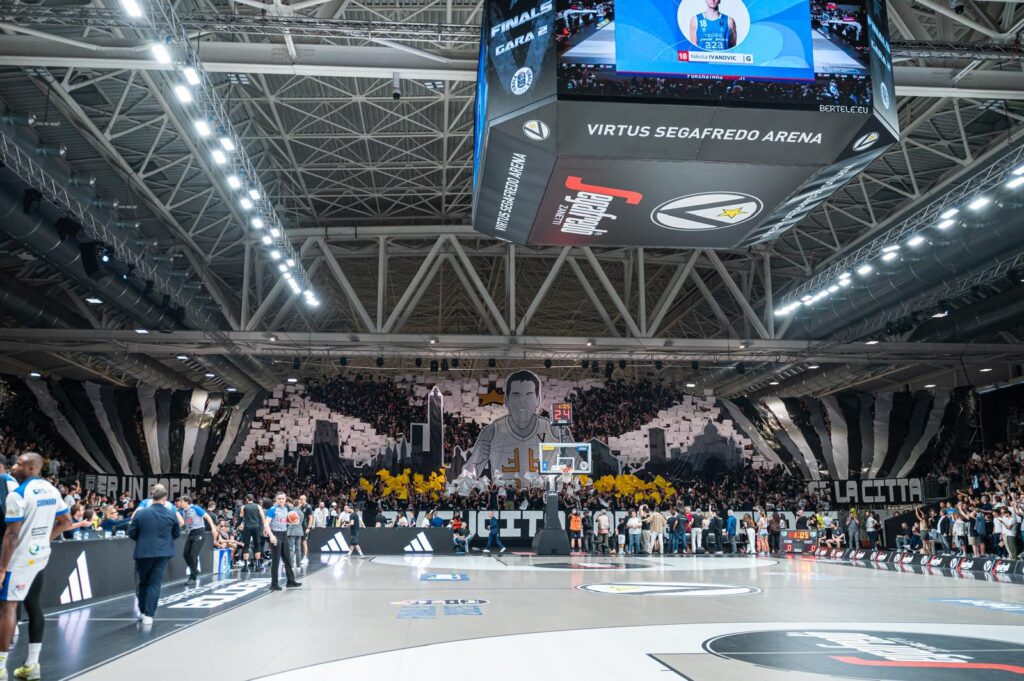In the Italian Basketball Championship (Lega Basket Serie A, LBA), the Scudetto finals mark the conclusion of the playoffs, following the regular season.
The recently concluded edition featured high-intensity games, tightly contested finals, decisive baskets, and a strongly engaged audience, particularly during the matches involving Virtus Bologna.
According to Anna Pasculli, Sales Manager at EMG/Gravity Media Italy, the company responsible for the television production of the entire championship, the quality of the technical setup and team coordination contributed to enhancing the event, delivering a visual setup that was both effective and coherent with the sports narrative.
Athletic performance was matched by a broadcast production that maintained high technical and narrative standards. From mid to late June, to cover the Scudetto finals, EMG Italy – Gravity Media deployed one of its flagship OB trucks, the Orion 209 unit.
Finals Setup
For the finals series, the production layout was enhanced compared to earlier phases. While semi-finals generally employ seven to eight cameras, the finals feature up to eleven operational units. The OB direction was further reinforced with a Jimmy Jib for dynamic shots and a reverse-side camera (bench side), expanding visual coverage and offering a broader range of perspectives.
One of the newly introduced elements was an RF camera mounted on a Gimbal — a more compact alternative to the Steadicam, capable of delivering fluid movement. This technology, already used in football production, allows for a more cinematic visual result. It uses a Sony camera and is progressively becoming part of the standard equipment for major sporting events.
Camera Layout
The typical finals camera configuration is as follows:
- Camera 1: main camera, positioned frontally, for wide shots of play.
- Camera 2: close-up for detailed coverage of players and actions.
Both are placed on the stands side, facing the benches.
- Cameras 3 and 4: handheld, positioned under the left and right baskets respectively.
- Camera 5: central handheld, focused on mid-court action.
- Cameras 6 and 7: Marshall-type action microcameras installed on the backboards, fibre-connected.
- Camera 8: reverse camera on the bench side, shoulder-operated and cabled, used for time-outs and alternative perspectives.
- Camera 9: RF Gimbal for fluid, mobile shots.
- Camera 10: additional unit, depending on game configuration.
- Camera 11: clock camera, fixed on the game clock for refereeing checks.
All positions are crewed, except for the clock and microcameras (6 and 7).
An Instant Replay system, equivalent to VAR in basketball, is installed at the referees’ table. It includes two ambient microphones to allow on-air playback of official discussions during action reviews.
Graphics and Broadcast
As with the regular season, the finals’ broadcast production is managed by EMG/Gravity Media Italy, which supplies a host feed and customised versions for simultaneous distribution on Eurosport, Discovery+, and DAZN.
Graphics are managed by Boost Graphics, the graphics and virtual production subsidiary of EMG / Gravity Media, specialising in live data integration and fan engagement solutions.
The production team for the finals includes around 30 professionals. Given that the sports arenas are only partially pre-cabled, setup operations are complex. While the regular season typically uses 4–5 cameras, finals coverage extends to 10–11, requiring significant on-site integration with additional equipment.
Broadcast Control and Customisation
Production is carried out entirely on-site aboard the OB Truck Orion 209, although during the season EMG Italy also operates via remote production and centralised Instant Replay from its Cologno Monzese facility.
A second dedicated unit is deployed for Discovery’s coverage. For DAZN, content customisation is handled directly onboard the main OB unit, which is configured with two parallel control rooms, each with independent audio and video compartments. This enables separate productions within a shared infrastructure.
Instant Replay and Operational Workflow
Tommaso Gargàro, EMG Italy – Gravity Media’s technical manager for the finals, notes:
“The new setup required extensive preparatory work. All operations – including graphics and Instant Replay – are carried out locally at the venue.
The Instant Replay is managed by a dedicated computer system that continuously records all camera feeds. When a review is needed, it allows selection of the most suitable angle and enables zooming in on critical details – such as a foot on the line or the moment the ball leaves the hand before the buzzer.
The most sensitive phases of the Instant Replay are also broadcast live using a 2-box layout that shows the same footage as seen by the referee team.
For broadcast replays, two EWS 12-channel systems are installed onboard the OB Truck. Instant Replay, however, is handled separately by a sideline operator, approached directly by referees for action reviews.”
###
© 2025 EMG Italy / Gravity Media – Presspool PressOffice RobertoLandini



